This game was born from a desire to meld together my love for two seemingly different worlds: board games and Greek mythology. Inspired by countless days and nights enamoured by the tales of lesser-known Greek gods and heroes, as well as many hours of my life spent playing various Eurogames. Thus, I hoped to captivate the hearts of enthusiasts from both realms.
The Narrative
Amidst the celestial realm of Mount Olympus, a storm brewed that left echoes of rebellion. The Gods, once united under the rule of Zeus, found themselves torn and divided against their allegiance and ambition. The first Olympian Revolt had failed. The deities Hera, Demeter, Poseidon, Hades, and Aphrodite are held captive by Zeus and his minions.
This is where your story begins. You’ve been called to the Second Olympian Revolt.
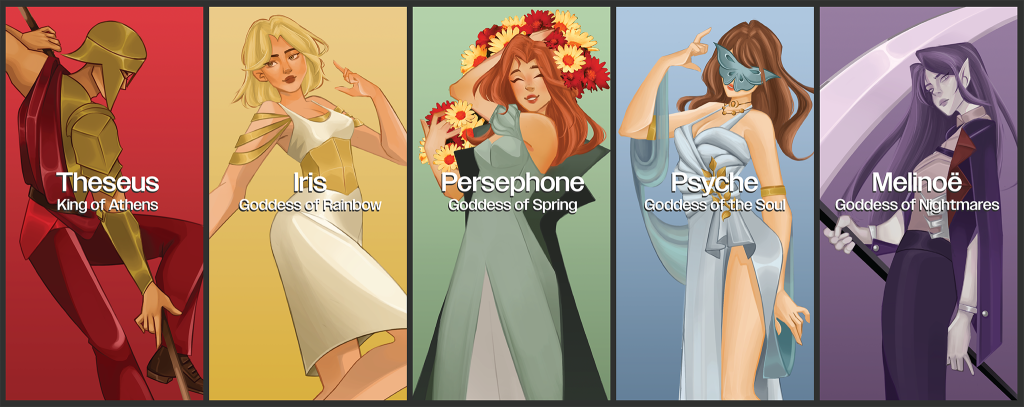
Theseus, a son of Poseidon, was widely regarded as the greatest Athenian hero after the slaying of the Minotaur, the half man half bull that inhabited the labyrinthine palace of Minos at Knossos.
Theseus is the vibrant red thread that weaves strength, valour, and determination into every battle they face; a force to be reckoned with. He represents courage, sacrifice, as well as passion, the embodiment of unyielding strength and the fierce warrior of the group. With that in mind, I allowed myself to get inspired by ancient Greek military pieces of equipment: the linothorax (upper body armour), cuirass (chest armour), greaves (shin guards), as well as the military spears commonly used by the hoplites, the dory.
Iris is the goddess of the rainbow and the messenger of the Olympian gods, acting as the handmaiden and personal messenger of Hera.
Iris’ bond with the colour yellow reflects her innate joy and optimism; her connection to the mystical realms illuminates the secrets of the past and foresees the possibilities of the future. Iris was the first character to come to mind, and the one to band this group of Gods together. I wanted to make a character that exudes an otherworldly charm, someone whose unwavering guidance serves as a lighthouse amidst the shadows.
Persephone is known as the Goddess of Spring, as well as infamously known as the Goddess Queen of the Underworld, ruling alongside Hades.
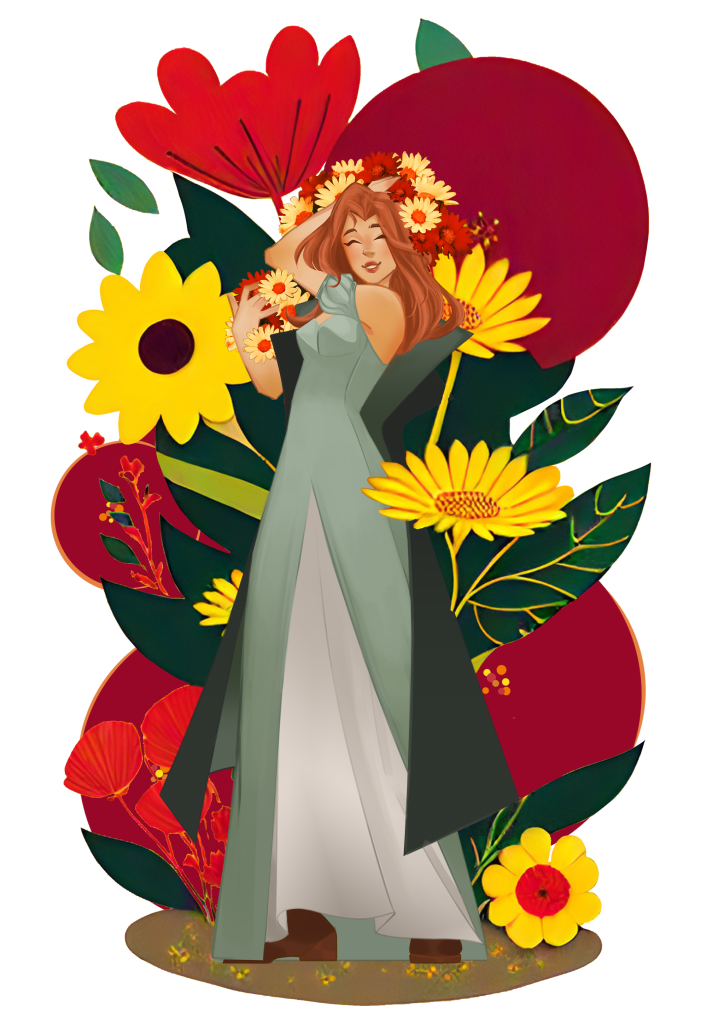
Persephone is a serene and nurturing presence within the group, embodying the colour green that reflects her boundless love for all living things as well as her deep understanding of life. As a parent herself (to Melinoë), it is her role as a mother figure that she truly shines. As the caretaker, she tends to wounds and dispenses remedies with her vast understanding of healing herbs. She is also symbolised by pomegranates, a Greek symbol of good luck and blessings. Her design, selfishly, is loosely based on my own mother and her love for gardening and cute dresses.
Psyche, one of the most celebrated characters in Greek mythology, whose beauty has rivalled that of Aphrodite, the goddess of love, the mother of her husband.

Psyche is the only one on the roster who came from a mortal background and was later granted immortality by the Gods. Psyche’s embodiment of the colour blue mirrors, her connection to the depths of emotions, and the expansiveness of the soul. She radiates a soothing presence that speaks to her deep understanding of the human spirit and soul, after all, she was human in the past. A blue butterfly lingers over her eyes as she vows never to see another person’s face again; only their soul. What physical appearance is there to judge, when she is not able to see?
Melinoë is a goddess invoked in one of the Orphic Hymns and represented as a bringer of nightmares and madness. Her father, Hades, had been captured during his attempt at a rebellion.
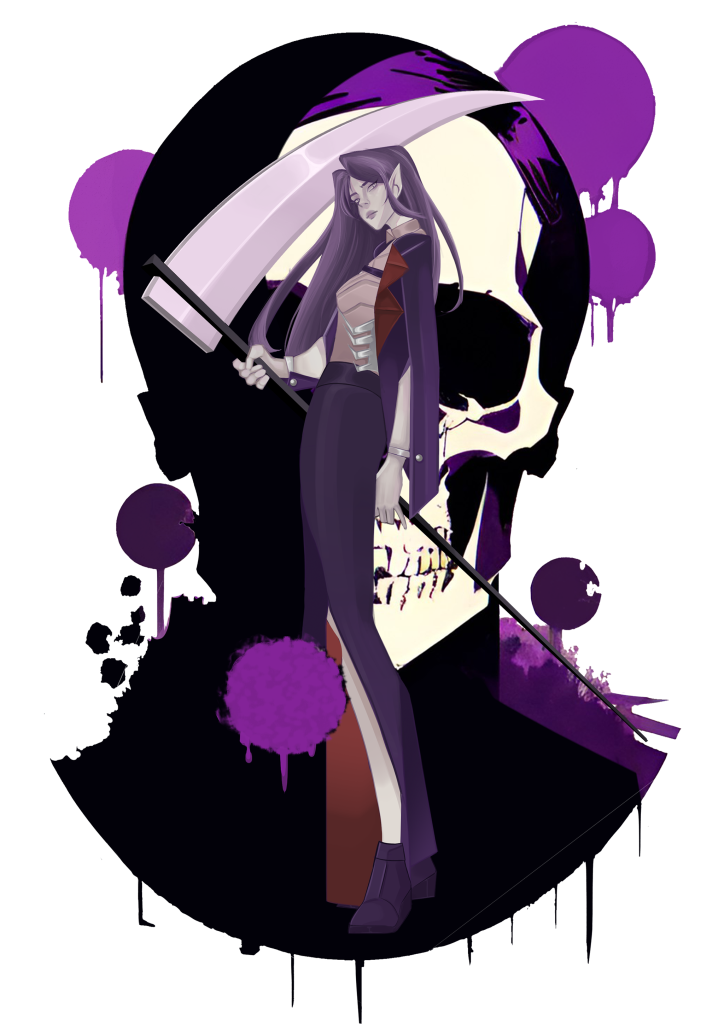
Melinoë, an enigmatic figure draped in regal shades of purple and grey. Her piercing gaze sees through illusions, fixated solely on execution. Melinoë’s stoic countenance stems from her resentment towards Zeus, her actual father. Her origin and her entire life may be unconventional, but as the group’s tactician, Melinoe reminds us that success is born from calculated steps when ironically she was not.
How to play
In this fully cooperative game for 1-5 players, each player starts by choosing a character and a set of starter cards.
At the start, a player takes a card from the Nemesis deck and places it (face down) on the leftmost field (labelled ‘1’).
Players can then play their hand to attack or scan an area, or save up Drachma (currency) to gain boons.
Each nemesis that makes it to the battle arena attacks the player. By the end of the player’s and Nemesis’ phase, the player discards their hand and the played cards and then draws six cards.
Whenever the player’s draw pile runs out of cards, shuffle the discard pile (including all the new boons gained) to make a new deck. This allows the deck to get stronger over time.
*The order for each player’s turn is listed on the game mat for ease of viewing.
Card Design
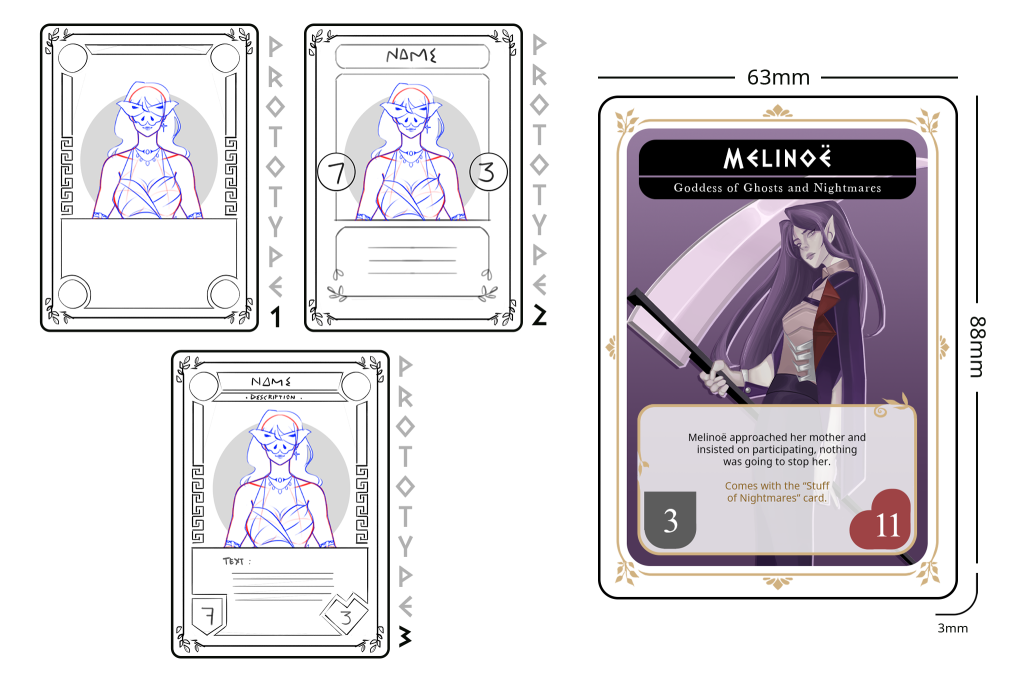
Designing the cards was a lot more challenging than the characters themselves; there were many things to consider: design, layout, typography, readability, material, illustration style, and more. I don’t want to hide the ugly. As designers, we’re often ashamed of our progress pictures, but I’m pretty numb to that now, so I’m also showcasing one of the earliest prototypes. As a board game enthusiast, I knew that a standard-sized poker card fits the best in most hands, thus I opted for rounded corners since no-one likes cards with (previously sharp) smashed corners.
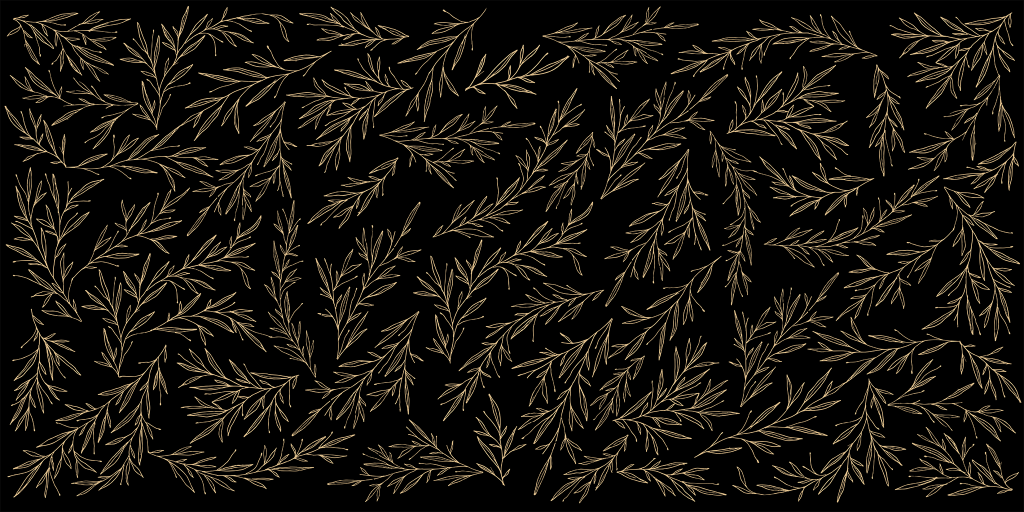
I also developed a golden olive leaf motif as they are often an integral part of ancient Greek as well as Roman culture. They represent wisdom, victory, and fertility, and therefore are also depicted alongside many deities, warriors, and mythological figures. I have also seen them in textile patterns, therefore I deemed it fitting as a general pattern to prevent any whitespace in the design.
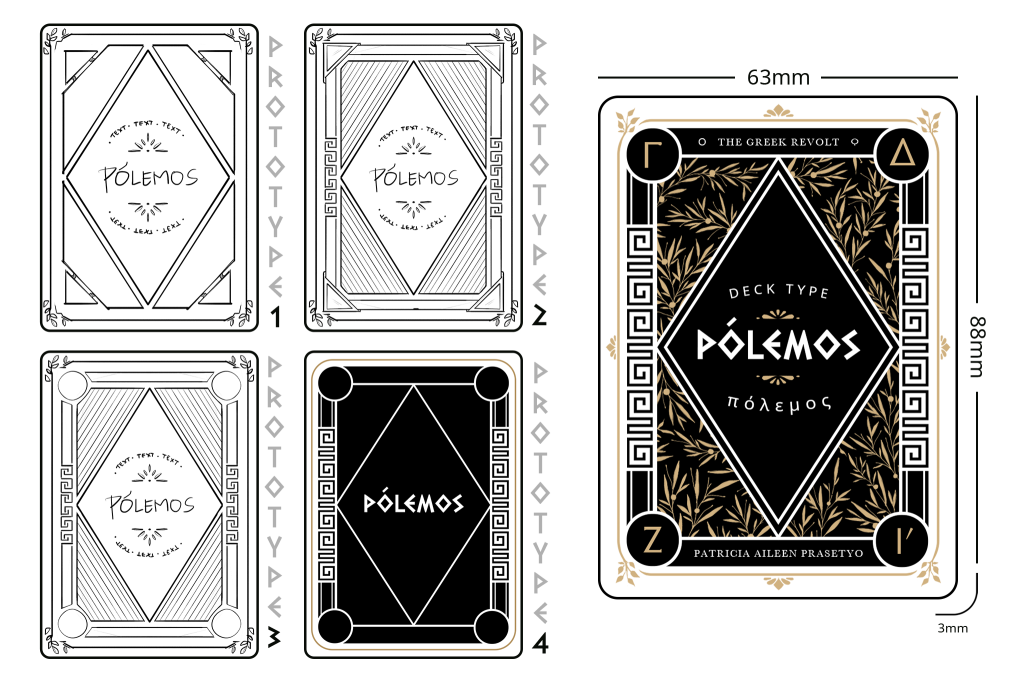
The backside of the card features a rich black background adorned with the golden olive leaves pattern that I designed to exude an air of timeless elegance and symbolic significance that is seen in many ancient Greek artworks and textile patterns to this day. The title of the project, Pólemos, is displayed on the front and centre of the card, and the Greek spelling/lettering “???????” is written under it. Above the title, the deck type is stated for easier organization. Other than the olive leaves on the black background and as the border of the design, I also included the fundamental design motif pattern of the Meandros (Meander), often used as a decorative band on Greek pottery. Lastly, I added the ancient Greek numbers ? (three), ? (four), Z (seven), and ?? (ten). The ancient Greeks believed that Z (seven) was a fortunate number and that the power of numbers was imperative to life itself. Z (seven) was a perfect number, as it consists of ? (four), the root of everything on earth, as well as ? (three), the number of the spirits that make up the father, mother, and son. They especially liked the number ten, called a Tetractys.
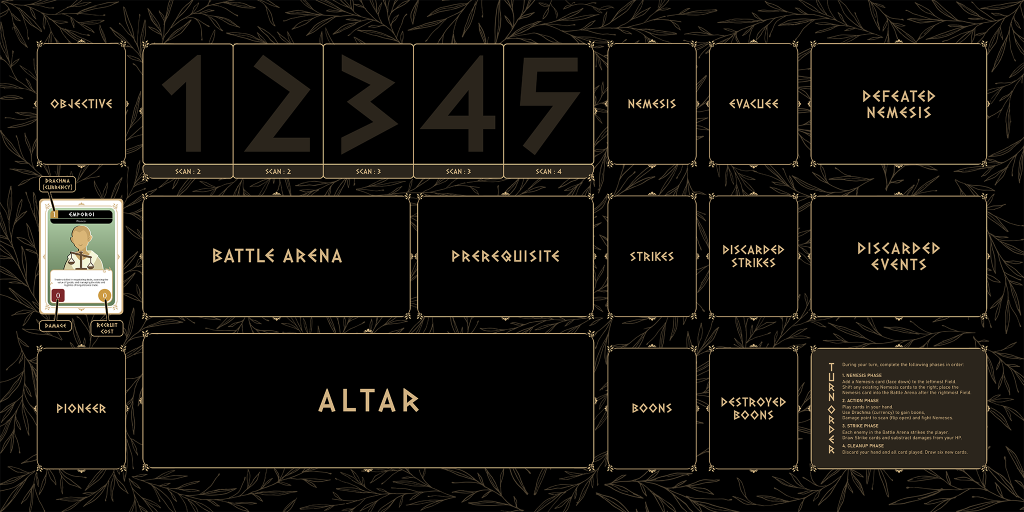
The game mat was printed on a sizable desk mat rather than a board. I’ve come to realise, thanks to much time spent with such boards, that the slippery consistency may look nice, but can be incredibly frustrating to have the cards slide around too easily. I had played on an old mousepad, and found that it worked surprisingly well! The card print finish was also a colourful hologram that coordinated with the overall colour scheme of the characters. I wanted the game mat to be matte to contrast with the cards’ shine.
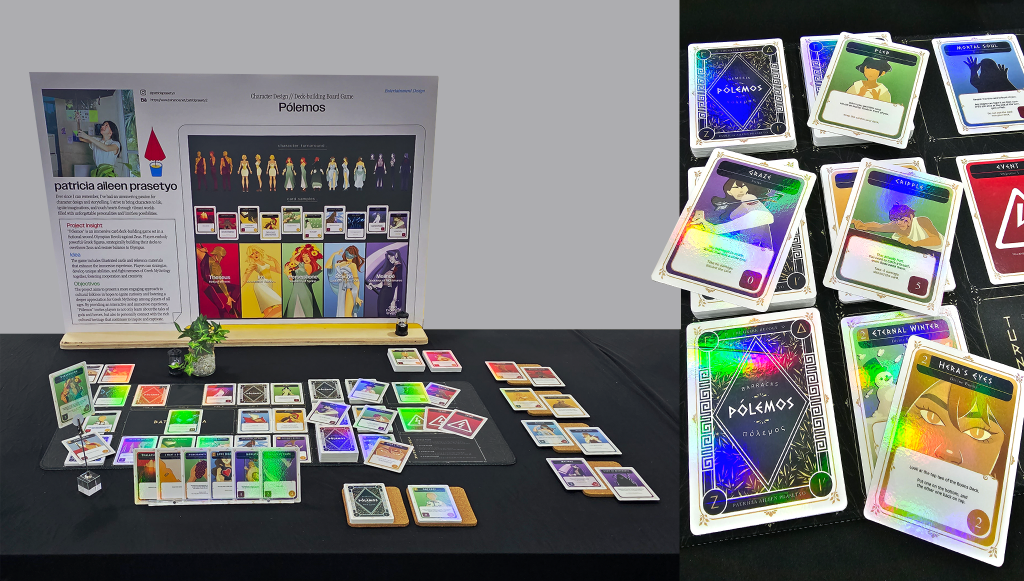

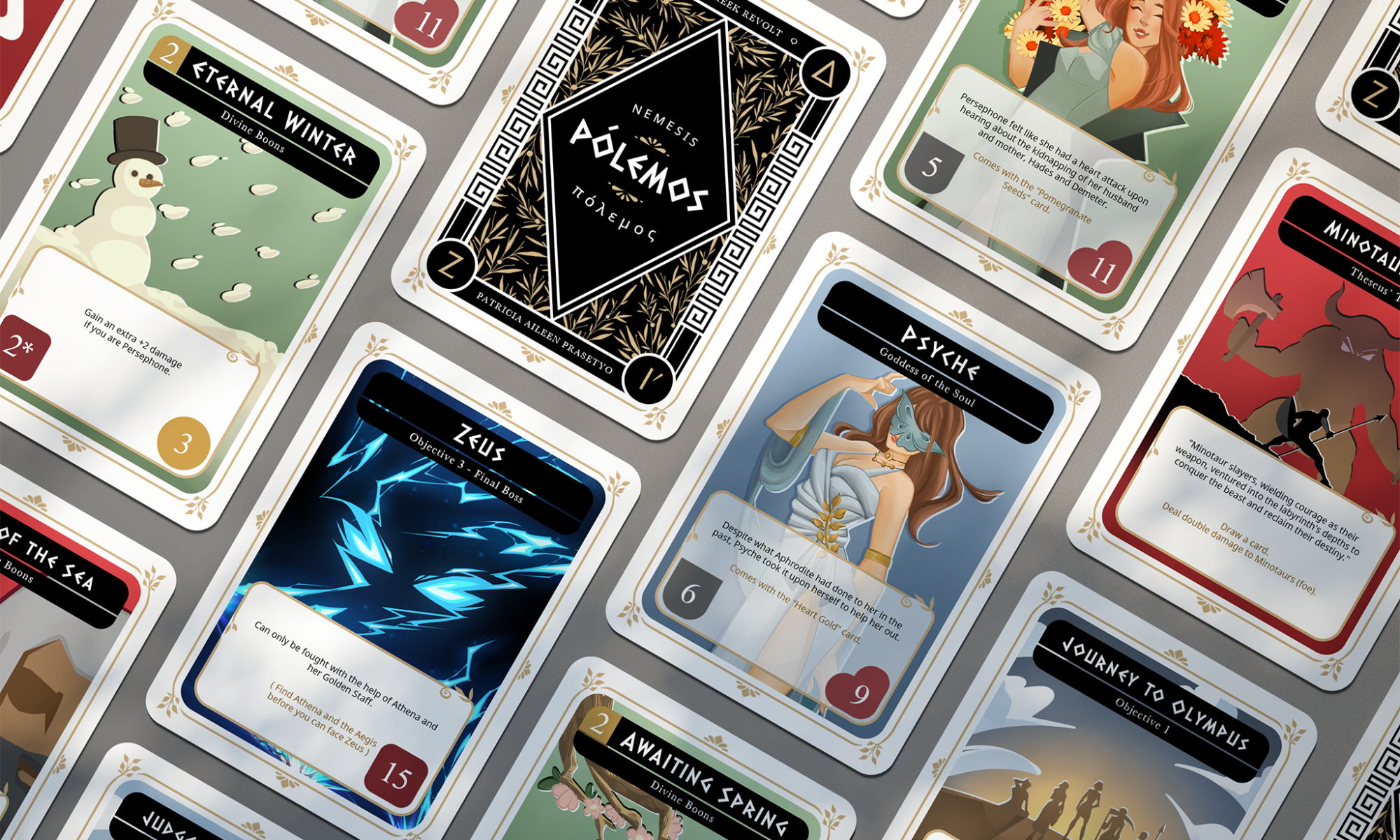
How to buy?